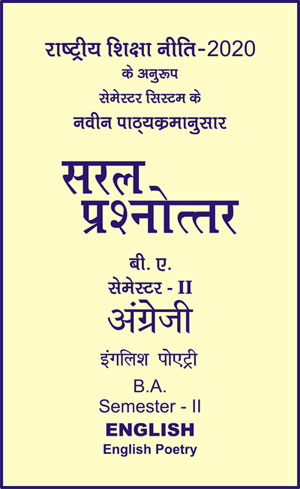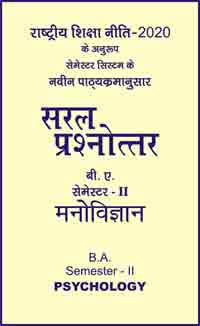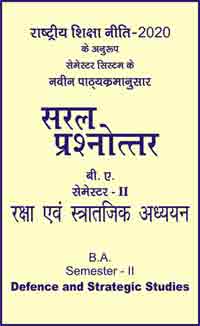|
बी ए - एम ए >> बीए सेमेस्टर-2 - अंग्रेजी - इंगलिश पोएट्री बीए सेमेस्टर-2 - अंग्रेजी - इंगलिश पोएट्रीसरल प्रश्नोत्तर समूह
|
5 पाठक हैं |
|||||||
बीए सेमेस्टर-2 - अंग्रेजी - इंगलिश पोएट्री
Chapter - 15
"The Lake Isle of Innisfree"
- W. B. Yeats
Life and Works of W. B. Yeats: In a Nut-shell
William Butler Yeats was born on June 13, 1865. His parents were Protestants. His father John, an Irishman, was a famous painter. In the beginning he was educated in London later on he shifted to Dublin. Here, he studied art for three years. He was never educated in a university..
He was an assertive man who played a vital role in the political and literature of Ireland. He founded the Irish Literary Theatre Society in collaboration with Lady Gregary. It made the must important figure of the Irish Literary Renaissance. This society organized performances of plays of many playwrights including those of Yeats himself. Meanwhile he fell in love with Maud Gonne. She was a charming, beautiful and distinguished Irish young lady. She was associated with a violent section of the Irish revolutionaries. She did not respond to his love. But he continued to love her and was inspired by her in many of his poems. When she did not seem inclined to marry him, he proposed to proposed to Geargle Hyde Lees. They were, in 1917, married.
Yeats was a poet who developed love for India. Rabindranath Tagore's Collection, "The Gitanjali] touched him. He helped the great Indian poet to revise many of the lyrics there. He also wrote an illuminating Introduction to this book. Another Indian who was associated with Yeats, was Purohit Swami. Sri Swami was a disciple of Lord Sri Hamsa. He helped Yeats in translating the ten principles of Upanishads into English. In 1922, he was made a member of the Irish Free State. When he involved in public affairs, and his private life had a sense of disillusionment, he realized that "Romantic Ireland in dead and gone". He now abandoned his old, ornamental style. The poetry of this phase shows his use of the idiom of the common speech. In 1923, he won the Nobel Prize for literature. He died in France in 1939.
Yeats began his career as a poet by writing in the tradition of the Pre- Raphaelite Brotherhood. The poems of this period have a dream-like atmosphere. They have been written in an ornamental style. His poetry of this period is also marked by his admiration for Irish legends and folklore. The poetry of the last phase is marked by his stream return to his passionate life. He has become a composer of a poem till now "as cold and passionate as the dawn". We find a greater austerity in style and a greater precision in the use of the language in his poetry of this age.
Yeats was a dramatist as well as a poet. His works, therefore, are both dramatic and poetical. His chief plays are "The Countess Cathleen' in 1892 and The Land of Heart's Desire' in 1898 and his chief poetical collection are The Winds among Reads' in 1899, "The wild Swans of Coole' in 1919, "The Winding Stair' in 1929, "The Tower' in 1928 and 'Responsibilities' in 1914. Few modern poems can have had so much artistry lavished upon them as "The Lake Isle of Innisfree' in 1895.
Symbolism of W.B. Yeats
In his early works Keats's 'symbolism' was quite simple, traditional and elementary. His innisfree symbolizes a Utopian, a country of the mind, where one can live in peace, away from the fever and fret of the world. Yeats use of symbols is at variance with that of the French symbols in more ways than one. His symbolism is contradistinguished from that of the French because it is mixed up and modified by his belief in magic, his nationalist views and outlook. His symbolism is fully and firmly grounded in Irish mythology and legend. His symbols are not vague or hazy. They have a well defined form. They are not obscure and indistinct..
The symbols of Yeats are all pervasive. There are certain key symbols round which a number of poems are arranged. As his art grew to maturity, his symbols became more and more complex and personal. Yeats was a symbolist from the very out set or his poetic career up to the last even before and after the brief spell of the French influence. As his powers attained maturity, his symbols acquired richness of associations evocative quality and intricacy. Symbolism enabled him to make his vision and traces concrete and substantial. Only in this way, he could convey to his readers a definite picture of his vague, fleeting sensations and experiences. Symbolism helped him to express the richness of man's deeper reality, something mystical in essence.
Yeats was a symbolist from the beginning to the end of his career and was regarded as the chief exponent of the symbolist movement in England. In the early stage of his career his symbolism is simple, easy to understand, like the traditional symbol of Rose. But in the course of time his symbols became complex, personal and individual. The Swan, The Tower, The Winding Stair, The Gyres etc., are symbols that frequently occur in his later phase. They are used in different poems in different senses. They are employed to convey his inner experience and visions which cannot be communicated in any other way. At their best they are highly evocative and significant. To them it is the impression of peculiar complexity, intensity and richness of his later poetry.
Imagery of W.B. Yeats
W.B. Yeats poetry is rich in images. "The Lake Isle of Innisfree' is an attempt at harmonizing concrete images with dream like images. In it, the symbolism employed and the images presented are not only suggestive and vivid but also appropriate and long-lingering. In this poem, the sight of a fountain inspires the poet to think of an imagery about the ideal island. Romantic imaginativeness blended with a strange but beautiful mysticism gives an air of wonderful sweet escapism. The entire poem seems to be a panorama of delightful sweet carvan of beauty splendour, tranquility and awe.
"The Second Coming' reflect Yeats's most esoteric ideas. It is also the picture of violence and terror of ideas. It is also the picture of violence and terror of the civil war in Ireland and the world war. As an expression of brutality of man, it has no parallel. The poem gains its strength from the compression, complexity and richness. The symbols are ambivalent and complex. The poem conveys the terror of coming antithetical civilization. It creates its effect by its images, by disgust at prevalent anarchy by horror at the overcoming of innocence, and by its slow remorseless revelation of Nature of what is to come. The image gradually draws towards Bethlehem, the traditional holy place of Christian worship, to be born. The poem expresses the filthy modern tide of a civilization.
As soon as the poet thinks about the new God, a strange image comes out of 'Spiritusmundi' the store-house of the poets's images. This merge is of fearful-sharp-half human and half beast. It has the body of a lion and the head of a human being. It is seen coming out of distant desert and going slowly to Bethlehem, the Birth place of Christ. The monstrous shape is so frightful that birds fly away in utter fear. The shape has fearful and blank. It is the symbol of violence and mercilessness. Its birth is the death of the present civilization. Here Yeats is of the view that the modern civilization is full of violence. So to end it, a violent God is required. That is why, the poet visualizes such a merciless and cruel looking beast as the new God. The sound of the rocking of the cradle is heard and this means the new God has taken birth. Thus the theme of the poem is the prophecy of the new civilization has been analysed in a philosophic and symbolic manner.
The poem is full of effective images and symbols. They have made the poem meaningful and popular the 'gyre' or 'circle' symbolizes the cycle of history. The cycle moves and like it, history repeats. The Falcon which means the hunting hawk stands for man's intellect. The Falconer-the hunter or the keeper of the Falcon stands for man's soul. Intellect, further, is associated with science while soul with spiritual or moral value. The Falconer (keeper) has no control on his own mind. This further symbolizes that science has destroyed moral values. Then the circumstances loses control on the centre and the whole cycle is broken. This means the central belief around which our civilization rotates, has lost its power and the whole society suffers from 'disintegration and disorder'.
The poem "The Second Coming' is steeped in striking images. 'Spiritual mind' itself has been described as the store-house of Yeats's images. The image of the strange God comes out of the store-house. It stands for cruelty which is needed to end cruel social forces. Then the images of the integral force of the world turning into the disintegrating force are striking images. The sphinx symbolizes the Egyptian sun-god. It also symbolizes the Greek monster, who killed the travellers, who could not answer his riddles. The rocking craddle symbolizes the craddle of Jesus Christ. The last stanza has three key images a desert, the light of birds and the terrible monster. Finally, the title of the poem symbolizes the rebirth of God and birth of new civilization.
The Lake Isle of Innisfree
(Substance of the Poem)
The poet is standing on a roadway in London. He falls into a mood escapism at the sight of a tinkling fountain. He wants to escape the lonely Island of Innisfree. He wishes to build there a small cabin of clay and twig. He will have a hive for the honey bees and live alone in the glade, resounding with the buzzing of bees. He will enjoy the peace of the island and the sight of mist in the morning. He will hear the songs of the cricket. He will enjoy the light of midnight and noon. He will hear in the evening the delightful songs of linnets. He will arise and go to the island of his heart. He hears the call of the island day and night. He hears in his imagination, the sound of the rivers of the island washing the shore. The wonderful Island haunts him even while he is standing on the roadway or pavements. The call of the island is irresistible. Now he is determined to answer it.
कविता का हिन्दी सारांश
कवि लंदन में सड़क के किनारे खड़ा है। झरने के बहने का दृश्य उसमें पलायन का भाव भर देता है। वह इनिसफ्री के एकान्त द्वीप में पलायन करता चाहता है। वहाँ पर वह मिट्टी एवं पत्तों की एक कुटिया बनाएगा। वहाँ पर एक मधुमक्खियों का छत्ता होगा। वहाँ पर वह अकेला रहकर मधुमक्खियों की गुनगुनाहट का आनन्द लेगा । वह द्वीप की शान्ति और सुबह के कोहरे का आनन्द उठाएगा। वह झींगुरों के गीत सुनेगा । वह अर्धरात्रि एवं दोपहर का आनन्द उठाएगा। वह शाम को लिनेट के गीत सुनेगा । वह उठेगा और अपने प्रिय ट ापू पर चला जाएगा। वह रात-दिन टापू की पुकार को सुनता है। वह कल्पनाओं में द्वीप की नदियों के किनारों से टकराती हुई आवाज सुनता है। टापू उसे उस समय भी प्रेरित करता है। जब वह सड़क के किनारे खड़ा है। उसकी पुकार का प्रतिरोध सम्भव नहीं है। अब उसने उसको उत्तर देने का निश्चय कर लिया है।
Points to Ponder (About the Poem)
- The poet is standing on a roadway in London, and at the sight of a tinkling fountain, fall into mood of escapism, he wants to escape to the lonely island of Innisfree.
- He will build there a small cabin of clay and twigs. He will have a hive for the honey bee, and live along in the glade, resounding with the buzzing of bees.
- He will enjoy the peace of the island, the sight of mist in the morning. He will hear the songs of the cricket.
- He will enjoy the light of midnight and noon. He will hear in the evening the delightful songs linnets.
- He will arise and go to the island of his heart. He hears the call of the island day and night. He hears in his imagination the sound of the rivers of the island washing the shore. The wonder island haunts him even while he standing on the roadway or pavement. The call of the island is irresistible. Now he is determined to answer it.
|
|||||
- Chapter - 1 Forms of Poetry & Stanza Forms
- Objective Type Questions
- Answers
- Chapter - 2 Poetic Device
- Objective Type Questions
- Answers
- Chapter - 3 "Let Me Not to the Marriage of True Minds" (Sonnet No. 116)
- Objective Type Questions
- Answers
- Chapter - 4 "On His Blindness"
- Objective Type Questions
- Answers
- Chapter - 5 "Present in Absence"
- Objective Type Questions
- Answers
- Chapter - 6 "Essay on Man”
- Objective Type Questions
- Answers
- Chapter - 7 "Elegy Written in a Country Churchyard”
- Objective Type Questions
- Answers
- Chapter - 8 "The World is Too Much with Us"
- Objective Type Questions
- Answers
- Chapter - 9 "Ode on a Grecian Urn"
- Objective Type Questions
- Answers
- Chapter - 10 "Break, Break, Break"
- Objective Type Questions
- Answers
- Chapter - 11 "How Do I Love Thee?"
- Objective Type Questions
- Answers
- Chapter - 12 "Dover Beach"
- Objective Type Questions
- Answers
- Chapter - 13 "My Last Duchess'
- Objective Type Questions
- Answers
- Chapter - 14 "The Love Song of J. Alfred Prufrock"
- Objective Type Questions
- Answers
- Chapter - 15 "The Lake Isle of Innisfree"
- Objective Type Questions
- Answers
- Chapter - 16 "Church Going"
- Objective Type Questions
- Answers
- Chapter - 17 Rhetoric and Prosody - Practical Criticism
- Objective Type Questions
- Answers














